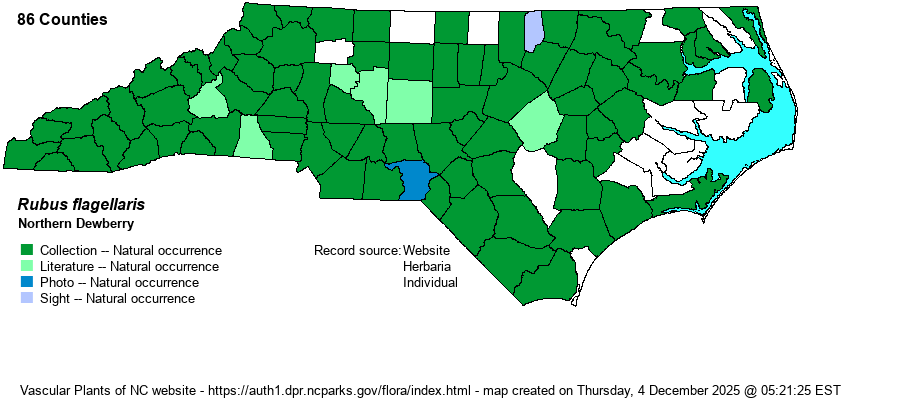| Author | Willdenow | |
| Distribution | Occurs statewide, and likely occurs in all 100 counties.
This species has a very wide range from southern Canada south to northern FL and parts of TX. | |
| Abundance | Common to very common across the state, not seemingly scarce in any areas. | |
| Habitat | This species has a great variety of open and disturbed habitats -- old fields, clearings, wooded borders, open woods, and thickets, mainly in mesic soils. |
| Phenology | Blooms in April and May; fruits from May to July. | |
| Identification | This is a straggling deciduous to tardily deciduous vine-like shrub, with long stems that trail on the ground for 6 feet or more. It usually has three leaflets but occasionally five. It has the same large white flowers of its more upright cousins. It has fairly numerous stout-based and curved prickles along the stems, though as the stems trail along the ground, an observer might not notice the prickles. A spiny, trailing “vine” with mostly three leaflets is most often this quite common species. One can easily trip over these stems when walking in a powerline clearing or an old field; if walking in sandals or without socks, your ankles can get heavily scratched. Two other “dewberries” (Rubus species that are trailing) are somewhat similar -- R. hispidus and R. trivialis, but they are armed only in slender and straight prickles and also may have slender bristles – not nearly as strongly “armed” as R. flagellaris. | |
| Taxonomic Comments | Weakley (2018) provides at least 20 (!) old or out-dated synonyms! There are no varieties recently recognized.
| |
| Other Common Name(s) | Trailing members of the genus Rubus have traditionally been called dewberries, as opposed to the “erect” blackberries. Alternate common names include Common Dewberry or simply Dewberry; also Northern Blackberry | |
| State Rank | S5 | |
| Global Rank | G5 | |
| State Status | | |
| US Status | | |
| USACE-agcp | UPL link |
| USACE-emp | FACU link |

